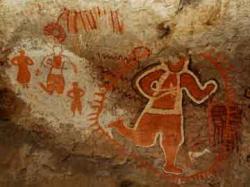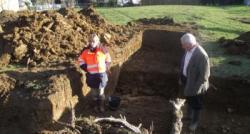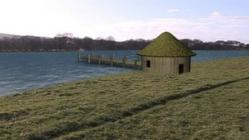25 JANVIER
INDI-UNI : ANTHROPOLOGY - ARCHAEOLOGY
INSCRIPTION 2012 COURS A DISTANCE
REGISTRATION 2012 ONLINE COURSES
BRESIL –  Rio de Janeiro - Not far from here at least 500,000 Africans took their first steps into slavery in colonial Brazil, which took in far more slaves than the United States and where now half of its 200 million citizens claim African descent. The “Cais do Valongo” – the Valongo Wharf – was the busiest of all slave ports in the Americas and has been buried for almost two centuries under subsequent infrastructure projects and dirt. That is, until developers seeking to turn Rio’s shabby port neighborhood into a posh tourist center allowed teams of archaeologists to check out what was being unearthed. “We knew we had found the wharf,” says archaeologist Tania Andrade Lima, showing a ramp made up of knobbly, uneven stones used by slaves. It lay beneath a layer of smoother cobblestones from a dock installed later for the arrival of a Portuguese royal. The wharf alone is nearly 22,000 square feet. “This gives a dimension to how huge the influx of slaves was,” says Lima.
Rio de Janeiro - Not far from here at least 500,000 Africans took their first steps into slavery in colonial Brazil, which took in far more slaves than the United States and where now half of its 200 million citizens claim African descent. The “Cais do Valongo” – the Valongo Wharf – was the busiest of all slave ports in the Americas and has been buried for almost two centuries under subsequent infrastructure projects and dirt. That is, until developers seeking to turn Rio’s shabby port neighborhood into a posh tourist center allowed teams of archaeologists to check out what was being unearthed. “We knew we had found the wharf,” says archaeologist Tania Andrade Lima, showing a ramp made up of knobbly, uneven stones used by slaves. It lay beneath a layer of smoother cobblestones from a dock installed later for the arrival of a Portuguese royal. The wharf alone is nearly 22,000 square feet. “This gives a dimension to how huge the influx of slaves was,” says Lima.
http://www.csmonitor.com/World/Global-News/2012/0125/Slave-port-unearthed-in-Brazil
MEXIQUE –  Cueva de las Monas - L'INAH annonce une campagne de restauration des peintures de la Cueva de las Monas, au nord de la ville de Chihuahua. Les restaurateurs traiteront douze ensembles de peintures tarahumaras et apaches elaborées sur les parois de cette caverne depuis l’an 500 . Certaines représentations ont des éléments iconographiques qui renvoient directement à l'usage rituel du peyote, ce champignon aux propriétés hallucinogènes.
Cueva de las Monas - L'INAH annonce une campagne de restauration des peintures de la Cueva de las Monas, au nord de la ville de Chihuahua. Les restaurateurs traiteront douze ensembles de peintures tarahumaras et apaches elaborées sur les parois de cette caverne depuis l’an 500 . Certaines représentations ont des éléments iconographiques qui renvoient directement à l'usage rituel du peyote, ce champignon aux propriétés hallucinogènes.
VIDEO INAH = http://www.youtube.com/watch?v=EHyM_ktAlxc
FRANCE –  Vic Fezensac - Les travaux de la future maison médicale, prévue par la communauté de communes d'Artagnan en Fezensac, ont mis au jour des vestiges et entraîné des fouilles qui dureront jusqu'à vendredi. « Nous lançons un diagnostic archéologique, nous effectuons des sondages, explique Aline Briand, de l'Institut national de recherche archéologique préventive. Nous creusons des tranchées avec la pelle mécanique, 2 m de large sur plusieurs dizaines de mètres de longueur », rajoute la chargée de l'opération et de l'étude à l'INRAP. Environ 7 % de la superficie du terrain seront examinés, sur les 4 000 m2 concernés. Si l'équipe découvre des vestiges, elle s'arrête dessus. Dans le cas contraire, elle descend jusqu'à la grave, à environ 1,50 m. « Lors du premier sondage, nous avons trouvé des vestiges antiques, des soubassements de piliers, sans doute, des niveaux de sol et de la céramique avec. » Dans ces conditions, un nettoyage s'impose et le diagnostic va permettre de détecter les vestiges, de les dater, de les caractériser. « Nous devons savoir sur quel type de site nous sommes », souligne Aline Briand.
Vic Fezensac - Les travaux de la future maison médicale, prévue par la communauté de communes d'Artagnan en Fezensac, ont mis au jour des vestiges et entraîné des fouilles qui dureront jusqu'à vendredi. « Nous lançons un diagnostic archéologique, nous effectuons des sondages, explique Aline Briand, de l'Institut national de recherche archéologique préventive. Nous creusons des tranchées avec la pelle mécanique, 2 m de large sur plusieurs dizaines de mètres de longueur », rajoute la chargée de l'opération et de l'étude à l'INRAP. Environ 7 % de la superficie du terrain seront examinés, sur les 4 000 m2 concernés. Si l'équipe découvre des vestiges, elle s'arrête dessus. Dans le cas contraire, elle descend jusqu'à la grave, à environ 1,50 m. « Lors du premier sondage, nous avons trouvé des vestiges antiques, des soubassements de piliers, sans doute, des niveaux de sol et de la céramique avec. » Dans ces conditions, un nettoyage s'impose et le diagnostic va permettre de détecter les vestiges, de les dater, de les caractériser. « Nous devons savoir sur quel type de site nous sommes », souligne Aline Briand.
http://www.ladepeche.fr/article/2012/01/25/1269033-vic-fezensac-des-vestiges-sur-le-site-de-la-maison-medicale.html
ROYAUME UNI –  Star Carr - The circular structure at Star Carr near Scarborough was found in 2008 and dates from 8,500BC. Nicky Milner, an archaeologist from the University of York, said the site was deteriorating rapidly. "The water table has fallen and the peat is shrinking and it is severely damaging the archaeology," she said. "The water keeps the oxygen and bacteria out and because they are now going into these deposits that is causing a lot of problems. "We haven't got much time left to excavate and we want to do some specialist analysis before all this important information vanishes forever." The site was first discovered in the 1940s and has since been the subject of extensive research. The latest excavation led to the discovery of what would have been a 3.5 metre diameter house occupied by hunter gatherers about 11,000 years ago. The remains were dated by radio carbon and the type of tools used helped identify the house as being from 8,500BC. The discovery suggested that people from this era were more attached to settlements than had been previously thought. Items such as the paddle of a boat, arrow tips, masks made from red deer skulls, and antler head-dresses which could have been used in rituals, have all been uncovered. Dr Milner said: "What we have here is a massive site, we have structures and we have a timber platform on the edge of what would have been a lake. This suggests that people were living here for quite a long period, for generations, in a large group. "We have to do more excavation to understand more." Star Carr would have been settled at the end of the last Ice Age and the team believes it may also offer insights into how people reacted to climate change.
Star Carr - The circular structure at Star Carr near Scarborough was found in 2008 and dates from 8,500BC. Nicky Milner, an archaeologist from the University of York, said the site was deteriorating rapidly. "The water table has fallen and the peat is shrinking and it is severely damaging the archaeology," she said. "The water keeps the oxygen and bacteria out and because they are now going into these deposits that is causing a lot of problems. "We haven't got much time left to excavate and we want to do some specialist analysis before all this important information vanishes forever." The site was first discovered in the 1940s and has since been the subject of extensive research. The latest excavation led to the discovery of what would have been a 3.5 metre diameter house occupied by hunter gatherers about 11,000 years ago. The remains were dated by radio carbon and the type of tools used helped identify the house as being from 8,500BC. The discovery suggested that people from this era were more attached to settlements than had been previously thought. Items such as the paddle of a boat, arrow tips, masks made from red deer skulls, and antler head-dresses which could have been used in rituals, have all been uncovered. Dr Milner said: "What we have here is a massive site, we have structures and we have a timber platform on the edge of what would have been a lake. This suggests that people were living here for quite a long period, for generations, in a large group. "We have to do more excavation to understand more." Star Carr would have been settled at the end of the last Ice Age and the team believes it may also offer insights into how people reacted to climate change.
http://www.bbc.co.uk/news/uk-england-york-north-yorkshire-16721738
USA – Delray Beach - Bones unearthed during the construction of an oceanfront mansion could be up to 3,000 years old, archaeologists have determined. The bones are believed to be those of an adult and a teenager who belonged to the Jeaga tribe, Native Americans who lived between southern Palm Beach County and the Indian River until about the 1700s, said archaeologist Bob Carr, of the Davie-based Archaeological and Historical Conservancy Inc. Carr said the bones could have been there at least 1,000 years and possibly as long as 3,000 years. The bones are not the oldest discovered in South Florida. According to the website of the Historical Society of the Palm Beaches, archaeologists have unearthed remains and artifacts at Riverbend Park on Indiantown Road, west of Jupiter, dating back to the Paleo-Indian period (10,000 to 7,500 BC). Other archaeological sites in Palm Beach County: Loxahatchee River Complex: includes earthwork and sand mounds. Jupiter Inlet Complex: includes a burial mound and several shell mounds made of discarded seashells. Riviera Complex: thought to be the main village of the Jeaga people. Boca Raton Inlet Complex: includes a burial mound and three shell mounds and black-earth rubbish piles.
http://www.palmbeachpost.com/news/archaeologist-bones-found-in-delray-are-between-1-2121923.html
ROYAUME UNI – York - Academics were collecting DNA from men with Viking names to see if they are directly descended from the Scandanavian traders and seaman who once ruled York and Yorkshire. It was the first of four gatherings across northern England and followed a public appeal for people with Viking surnames to come forward.
http://www.yorkpress.co.uk/news/9486699.Researchers_collect_DNA_from_men_with_possible_links_to_York___s_Viking_past/?ref=rss
LA REUNION - Le 23 janvier 2012 a commencé la première opération d'archéologie préventive dans l'histoire de La Réunion, réalisée par l'INRAP sous le contrôle de la direction des affaires culturelles – océan Indien (DAC-OI) et le département des recherches archéologiques subaquatiques et sous-marines (DRASSM) du ministère de la culture et de la communication. C’est dans le cadre du projet de nouvelle route du littoral que la Région Réunion a saisi les services de l’État au titre de l’archéologie préventive. Une équipe de l'INRAP va ainsi conduire une première campagne sur le domaine terrestre pendant une semaine sur l'aire de repos de La Possession. Ils rechercheront les vestiges laissés par l'homme depuis les premières occupations de ce site. Ces sondages archéologiques nécessitant l’utilisation de moyens mécaniques, l’accès au chantier est interdit au public pour des raisons de sécurité. Ce travail sera complété d’une étude historique puis d’une exploration sous-marine du littoral.
http://www.zinfos974.com/Nouvelle-route-du-Littoral-Premiere-operation-d-archeologie-preventive_a36818.html